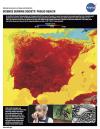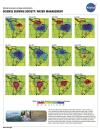You are here
Lithographs
NASA's Earth Observing System provides a variety of materials available for download. Feel free to choose a category below:
- Brochures
- Postcards
- Posters
- Science Writers’ Guide
- Mission Brochures
- Fact Sheets
- Calendars
- Booklets
- Lithographs
- Reference and Data Products Handbooks
- iBooks
- Activities
 |
Public Health (2005) The spread of chronic and infectious diseases is a serious threat to public health. Research has shown that many chronic and infectious diseases are related to environmental conditions. Organisms such as ticks and mosquitoes (called disease vectors) transport these diseases, and variability in rainfall and temperature has a major influence on the distribution and quantity of these pests. Recent outbreaks of West Nile Virus and other vector-borne diseases have illustrated the importance of having accurate and timely information to predict and respond to epidemics. This publication appears in: |
 |
Water Management (2005) The Earth is easily distinguishable from other planets in our solar system by the abundance of water on its surface. Water covers approximately 70% of our world’s surface, so it would seem that finding enough water suitable for human consumption, commerce, and ecosystems is a trivial task. But, only 2.5% of the Earth’s water is fresh and of that amount, more than two-thirds is locked away in glaciers and polar ice caps and is not available to for use by society. Therefore, fresh water is actually a limited resource. Increased demand from an ever-growing population threatens to deplete precious water resources. This publication appears in: |
